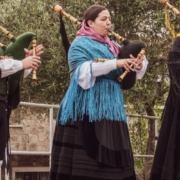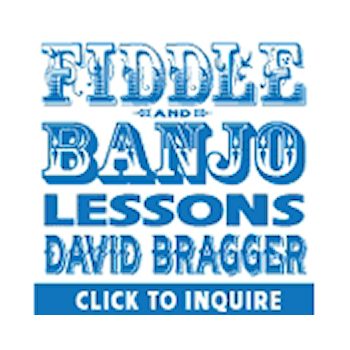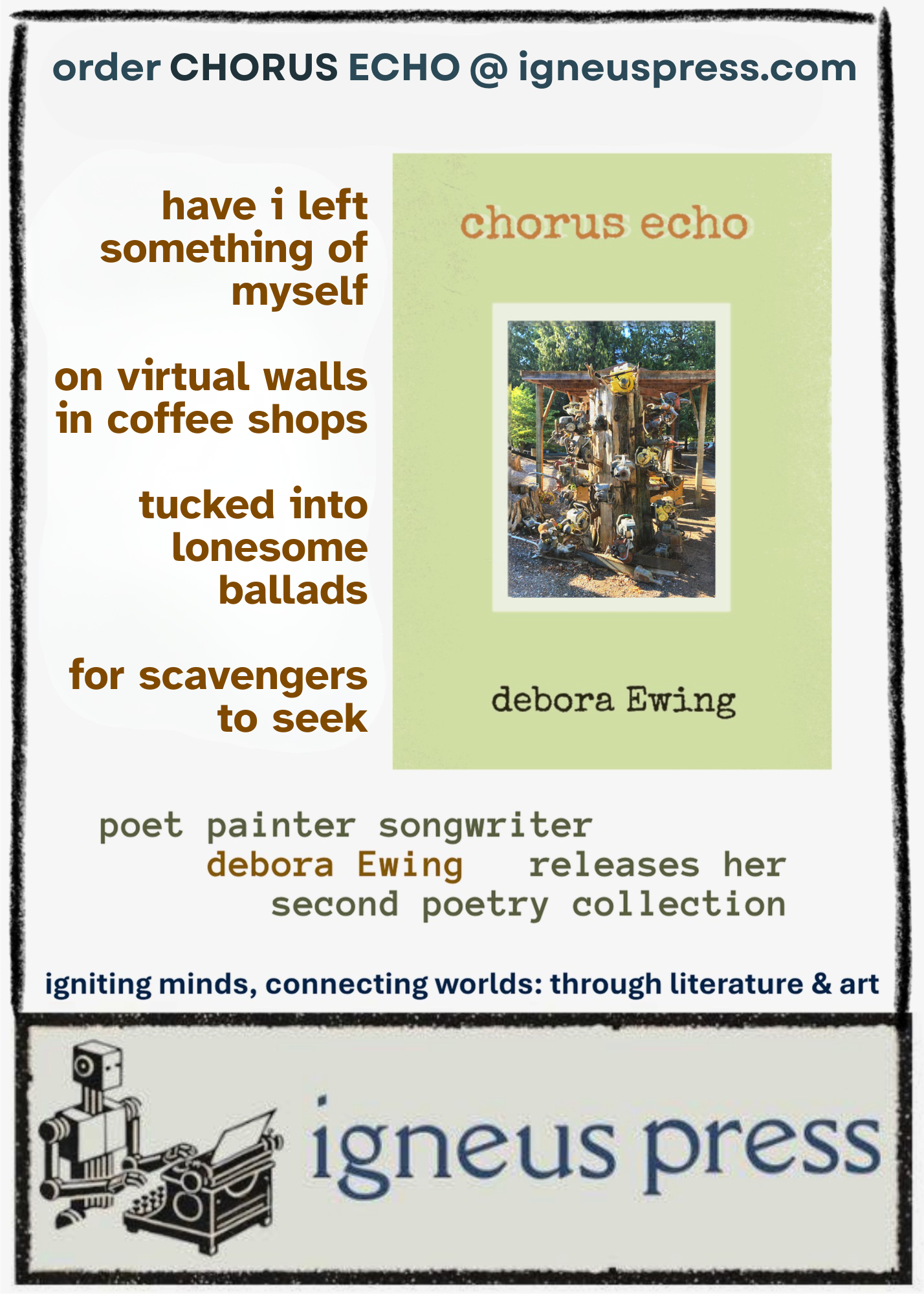Returning, Riotously Joy-Filled
Living Traditions #2, August, 2025
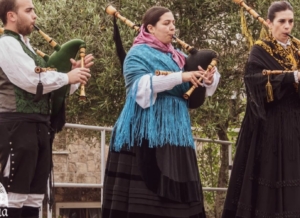
Gallegos/ Gaiteros playing the Gaita or Galician Bagpipers playing in chorus.
I’ve wanted to explore Galician music, and its connections to Irish traditional music for a long time, and finally got the nudge I’d needed to dive deeper from our good friends here at FolkWorks. We talked about looking to do an edition that involves the area in northern Spain known as Galicia. So my interest was piqued. Sitting in the northwest of the Iberian peninsula, Galicia lies closest to the route to the Celtic islands: sailing due north lands a vessel in County Cork. And Galicia includes a fascinating history of travel, indigeneity, emigration, and oppression, returning over and over to survival, so I asked some friends that play and study the Galician bagpipes (also known as Gaita) for answers.
For decades, I’d hear their strains echoing in the hills of an annual New Year’s music retreat, as they practiced to regale listeners in indoor places, their main purpose to encourage turn-of-the-year revelers. Imagine 5-15 Galician pipe musicians, or Gaiteros, simultaneously carrying an entire mountainside of sound to ring in the New Year with a bang with drums, pipes, hurdy gurdy, fiddle, and of course their own voices! It got me wondering, what is the thing that makes them sound so bold and memorable? My friend and music teacher, Elizabeth Todd from Monterey, CA, takes classes and workshops on Galician music each year among the redwoods and described it as “riotously happy.” I had to think about that. Each year, there are round dances and a throng of instruments with micro and half tones rippling out to fill every moment of space and sound with as much vibrancy as possible, culminating in an arrangement of secondline horn players, and gaiteros blending sounds from either side of the Atlantic in cacophonous glee. It was that which led me on my mental sojourn into the heart of Celtic Spain.
The region known as Galicia, home to cities like A Caruña, Lugo, Ourense, and Pontevedra, is where a mix of Celtic influences, post-Franco Spanish identity, and Moorish, Roman, and Gallic sounds all blend into something that nevertheless stands as its own unique thing. And, while it’s one of the least-acknowledged Celtic cultures at Celtic Festivals historically, it’s picking up steam. The Galician language is spoken by 2.7 million people, and, along with Spanish, is the official language of the region. Galicia also is well-known as a place for the blend of religious pilgrims to the City of Santiago Del Compostela, and older Pagan custom and culture as exhibited in myriad remnants of stone carvings.
In the Irish mythology and monastic traditions of more northern Celtic lands, tales of waves of immigrants — the Milesians, the Fir Bolg, the Fomorians, the Tuatha De Danann — crop up in the record. Recently these tales have begun to be mapped archaeologically to Neolithic, Ice Age, Bronze Age, or Iron Age waves of migration across Europe and, in particular, up from the Iberian land mass. Later, in the Common Era, there were waves of medieval pilgrims crossing the Celtic sea in both directions, and Elizabethan-period Spanish immigrants who brought their own characteristic cultural marks to the traditional song collection (“Spanish Lady” anyone?).
Across the music of Galicia and Ireland I found cultural and musical similarities that cropped up over and over: the prevalence of round or spiral dances; knotwork shapes seen in both social dances and neolithic carvings, cave paintings and woven fabric fragments. Some of this carries across highly ornamented dance and session tunes, with multiple falls of grace notes seeming to squeeze as much music as possible into a given phrase or melodic moment. The flexibility and expansion of the scale to include microtones, additional notes almost, creates a richness of textures to add to the fray. There seems also to be a predilection for a drone tone, available in most Galician instruments; this reflects the common practice of melodies that return to a central tonic, or midpoint in the key.
The sound of the bagpipes is common in every Celtic land, with subtle differences between the regionally specific instruments showing some of the markers of the style. Gaita tunes seem to wander away from the core notes, but come back over and over. Like a bee keeper who knows he must visit his bees regularly, he visits them again with increasing frequency, and the Gaitero does the same in their music.
Piper, Susana Seivane says of her Galician compositions that her deep love of Gaita may have started from her grandfather, but as she explored the ornaments with Irish musicians,, she emphasized that it has a resonance for lovers of both cultures, ancient Celtic and modern Iberian They visit their “home” notes more as the buzzing undercurrent hangs on to pulse the core notes, more often than in Irish tunes’ lightness. Despite individual songs that break convention with other regional style specifics, the pulse of the drone serves the rhythmic core as well as melodic and almost like stones skipping along the ground, the tune spends equal time in the air as it does with the solid earth.
I refer to Irish music as emphasizing the lift, spending only as much time as necessary touching down; whereas Scottish Music uses the turn of the pulse, driving its roots as strong as possible into the solid ground. I think Gaita tunes gather up all the parts of the cultures that comprise it, into a rhythmic midpoint, almost like a rhythmic drone, whether an instrumental drone is present or not.
And here as in the singing of Alalás, the singer Uxía shares her perspective on the traditional singing of the songs that do the same thing: they return with as much life as possible. Like poems they concentrate language and meaning into each element, where the return point is the thing that roots the people into both the past and the now, where more is more. More textures, tones, voices, ornaments layered rhythms, etc.
In order to eke as much out of the moment as is possible, the music, dance, and emphases in a single phrase all carry the weight of the necessity of grabbing onto life, with a tenacity that only hardship can shape.
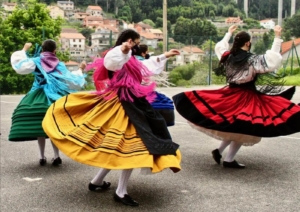
Gallegos , or Galician people, dancing, swirling.
As in Ireland, the sad songs contain the seeds of both the ecstatic joy and the sorrow that leaves its mark in these cultures. It is an expression of the laments of a people constantly invaded, and finding a return to life in the wake of loss, always enduring. The traditional Galician song style In Alalás songs I see, and more importantly feel, a shared emigrant culture, an awareness of their own diaspora. The oppression and expression of it all expresses the complexity of surviving and continuing through hardships.
For example, the renowned fiddler Begońa Riobó of Band Riobó never had many Galician references on record, thanks to Franco’s fascist repression of regional identities on the Iberian Peninsula in the early part of the 20th Century. This necessarily colors the drive to shape the music with as much fervency as possible. And it drives modern carriers of the tradition to dive hard into the sounds that they can, by looking into each and every influence, in instrumentation And repertoire to return and rebuild the Gallician musical identity.
Just like Irish, Scottish, Breton, and Newfoundland music, it’s expressed through links in the oral tradition, transmitted multigenerational by the people who hear and love its driving buzz. So while much was lost, much of it survives in other shapes and contexts as threads to pull back into the music. So while many instruments have come back into the fold, Accordion, Tambór, Fiddle, Gaita, reeded flutes, and tamborines, the Gaita can play more notes than a Highland bagpipe, marking its sound flexibility as unique. Even in the Northumbrian pipes we hear more frequently when we think of “Celtic” sounds. These same pipes can play more sounds, styles, influences, and keys than their bigger pipe step-siblings.
Susana Selvane refers to it as “old music for a modern audience.” which carries the seeds of what is still relevant, important, and essential to the people: endurance, incessance, and returning threaded throughout. That mad concentration and intensity of meaning, sound, and depth that only people who know both extremes can pour adequately into their music.
There’s a buzz that threads throughout the region’s traditional sounds that can’t be taken out of its proximity and historical transmission with the other Celtic cultures of the region. Each culture, violently colonized over and over by one empire after another, attempting to eradicate the identities of the indigenous people. And so we begin again: a return to the main melody, a return to the drone, a return to the root sound.
Here we see, Kepa Junkera, a Basque accordionist playing the song Terras Do Norté with the band Os Cempés on the album and book, Galiza, which he pays homage to Galician music.
They have a great collection of the drone like instruments that fill the soundscape to their utmost and showcasing the dogged determination to continue on as expressed in the music. Like the circular patterns of tombs, houses, and dances before the Columbian expansion, the music wraps back around itself to begin a cycle again and drive, riotously joyfilled across the modern world humming, buzzing, thrumming, and carrying forward to return over and over to itself.
Amelia Hogan is a San Francisco-based singer of traditional and contemporary Celtic Folk music with three folk-chart-topping solo projects, and numerous collaborative works. With her haunting, honey-toned voice, she tells the stories of songs from the Irish, Scottish, British, and American song traditions. Her performances are both in the Irish music tradition of Sean-Nós, or “old style,” a highly lyrical a cappella tradition, and also with accompaniment. She is the podcast host of “MixedMedia_Talks”, recently joined the Folkworks writing staff, and is also a painter and mixed media artist. Amelia fosters a deep love of community building in music education, and is committed to sharing how music can inspire spirituality and how spirituality moves people to make music. She can be found on Facebook, Instagram, and at www.ameliahogan.com, or in her San Francisco neighborhood with her husband and ghost-cat, sipping excellent tea.
Returning, Riotously Joy-Filled
Living Traditions #2, August, 2025

